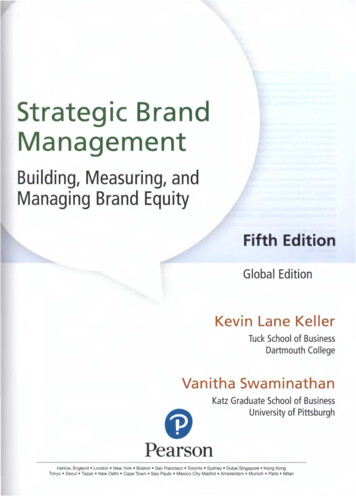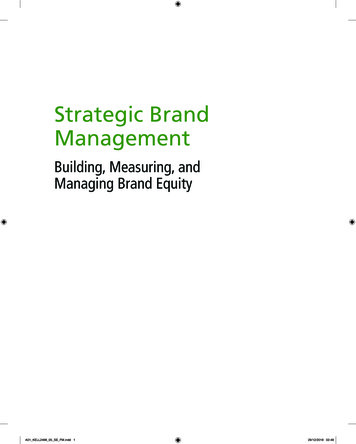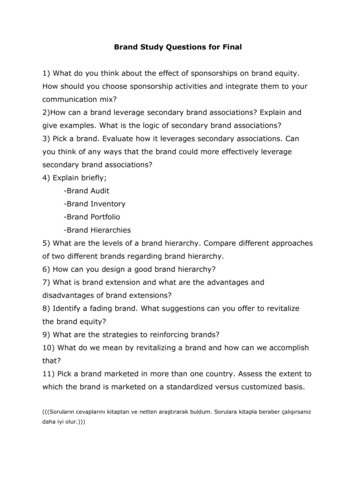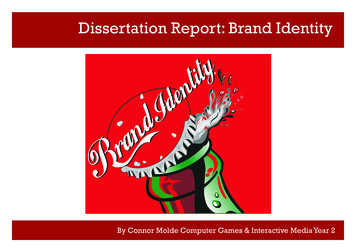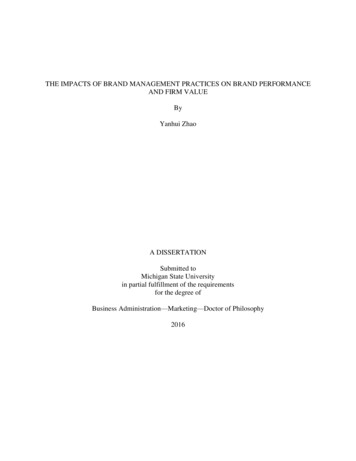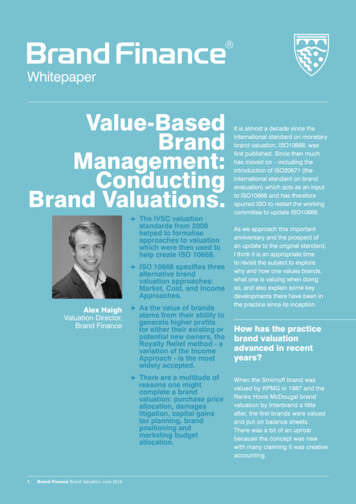
Transcription
nd Valuations. The IVSC valuationstandards from 2008helped to formaliseapproaches to valuationwhich were then used tohelp create ISO 10668. ISO 10668 specifies threealternative brandvaluation approaches:Market, Cost, and IncomeApproaches.Alex HaighValuation Director,Brand Finance As the value of brandsstems from their ability togenerate higher profitsfor either their existing orpotential new owners, theRoyalty Relief method - avariation of the IncomeApproach - is the mostwidely accepted. There are a multitude ofreasons one mightcomplete a brandvaluation: purchase priceallocation, damageslitigation, capital gainstax planning, brandpositioning andmarketing budgetallocation.1.Brand Finance Brand Valuation June 2019
Following that, financial reporting bodies worked to update accountingstandards that everyone could agree on. In 2003, IFRS 3 (BusinessCombinations), IAS 38 (Intangible Assets), and IAS 36 (ImpairmentReviews) were all created to overcome the issues. Most local GAAPsfollowed suit with similar standards and rules.IFRS 3 mandated that the value of an acquired business should be splitbetween all assets – tangible and intangible – plus general goodwill; IAS38 defined intangible assets; IAS 36 stated that the value of all of theseidentified assets should be reviewed for impairment every year.These standards – while stopping short of allowing internally generatedintangibles being put on the balance sheet – formally endorsed the ideathat intangible assets have value and can be valued accurately.How has Brand Valuation advanced recently?A timeline of Brand Valuation 20062008201020122014InternationalValuation StandardsCouncil (IVSC)20162018202020671The international standard inbrand evaluation.Performed a Brand Valuation ofCritics called it creative accounting IFRS 3 (Business Combinations) IAS 38 (Intangible Assets) IAS 36 (Impairment Reviews)10668The international standard inmonetary brand valuation.Created to standardise brand valuetreatment. Formally endorsed thevaluation of intangibles11.The valuation standards from the International Valuation StandardsCouncil (IVSC) from 2008 helped to formalise the various approaches tovaluation which were then used to help create ISO 10668, the internationalstandard in monetary brand valuation which was published in 2010. Inconjunction with all of the main parties in brand valuation (including theBig 4 accountancy firms), ISO 10668 constitutes a meta-standard that laysdown the general framework for doing brand valuations.It states that brand valuations should be based in Behavioural Analysis(how brand reputation impacts behaviour), Financial Analysis (how thatbehaviour impacts business performance) and Legal Analysis (whether ornot the supposed owner really has rights over that benefit).2.Brand Finance Brand Valuation June 2019
It also states that brand valuations should be transparent (i.e. all theassumptions are clear and auditable), consistent (i.e. easily replicable),and independent.ISO 10668All brand valuations should be conducted based on analysis from three dependentAnd all brand valuations should be:Transparent12This standard is now being supplemented by ISO 20671 (BrandEvaluation), which looks more closely at the behavioural aspect of thisanalysis and the way this can be influenced. Other organisations arefollowing suit with independent standards from the likes of MASB in theUS and qualifications like the “Certified in Entity and Intangible Valuations”which was created by AICPA, ASA and RICS.All of these are professionalising the industry and we at Brand Financefeel it is important for anyone involved in this area to support theseinitiatives for the benefit of all businesses as well as the reputation andcredibility of the valuation industry specifically.How do you identify abrand’s value to abusiness?Overarching these methods are the general “approaches” to thevaluations which are common to any type of valuation – not just those ofbrands. ISO 10668 specifies 3 alternative brand valuation approaches the Market, Cost and Income Approaches.The purpose of the brand valuation; the premise or basis of value; andthe characteristics of the subject brand dictate which primary approachshould be used to calculate its value.3.Brand Finance Brand Valuation June 2019
Market approachThe market approach measures value by reference to what otherpurchasers in the market have paid for similar assets to those beingvalued. The application of a market approach results in an estimate ofthe price expected to be realized if the brand were to be sold in the openmarket. Data on the price paid for comparable brands is collected andadjustments are made to compensate for differences between thosebrands and the brand under review.As brands are unique and it is often hard to find relevant comparables thisis not a widely used approach.How do you identify a Brand’s Value to a business?ISO10668 specifies 3 alternative approachesMarketComparable TransactionsCostEstimate FairValue of theBrandDataAdjustments based onBrand in questionIncomeAs brands are unique and it is often hard to find relevantcomparables this is not a widely used approach.13.4.Brand Finance Brand Valuation June 2019
Cost approachThe cost approach measures value by reference to the cost invested increating, replacing or reproducing the brand. This approach is based onthe premise that a prudent investor would not pay more for a brand thanthe cost to recreate, replace or reproduce an asset of similar utility.As the value of brands seldom equates to the costs invested creatingthem (or hypothetically replacing or reproducing them) this is not a widelyused approach.How do you identify a Brand’s Value to a business?ISO10668 specifies 3 alternative approachesMarketCostCost toRecreateCostInvestedCost toReplaceIncomeThe value of brands seldom equates to the costs investedcreating them, therefore this is not a widely used approach14.5.Brand Finance Brand Valuation June 2019
Income approachThe income approach measures value by reference to the economicbenefits expected to be received over the remaining useful economic lifeof the brand. This involves estimating the expected future, after-tax cashflows attributable to the brand then discounting them to a present valueusing an appropriate discount rate.As the value of brands stems from their ability to generate higher profitsfor either their existing or potential new owners this is the most widelyaccepted and used brand valuation approach.How do you identify a Brand’s Value to a business?ISO10668 specifies 3 alternative approachesvsMarketPricePremiumMarketShareCost Various waysto quantify thisimpactIncomeRelief fromRoyaltyPrice IncrementalCash Flow15.When conducting a brand valuation using the income approach variousmethods are suggested by ISO 10668 to determine future cash flows.The most widely accepted method is “Relief from Royalty” (also knownas Royalty Relief) which estimates the value based on the royalties notgiven away by a company as a result of the company owning the brandand not having to licence it from a third party. This method fits with the“separability” criterion of the international financial reporting standards,its assumptions are based in real-world agreements and the number ofassumptions is low. It is therefore easily auditable and easily replicable.The royalty relief method is in almost three quarters of technical brandvaluation methods according to Gabi Salinas and Tim Ambler’s report(A taxonomy of brand valuation practice: Methodologies and purposesin Journal of Brand Management 17(1):39-61 · September 2009).However, it implicitly only identifies the value to a licensor – ignoring anybenefit left within a licensee.6.Brand Finance Brand Valuation June 2019
We therefore supplement this approach with an approach called“Incremental Cash Flow” which identifies the value of the businessthrough a discounted cash flow method and then identifies how demand,free cash and therefore long term value will drop in the subject business ifit were to have to use a generic brand. The difference between the valuewith the brand and the value without it is the brand value in this case or, aswe call it, the “brand contribution”.In order to identify this brand contribution, valuers need to identify howspecific brand attributes are impacting people’s likelihood to purchase– a market research technique known as “Demand Driver Analysis”,sometimes referred to as “Brand Drivers Analysis”. This analysis is usedin over 80% of valuations used for management purposes, according toSalinas’ and Ambler’s report.The incremental cash flow method is best used for identifying incrementalopportunities rather than the overall value of the brand because identifyingwhat a generic brand is can be relatively subjective. For this reason, aswell as the separability issue, the method is not used by technical valuerswhere assumptions on this supposed generic brand will have to besubject to intense questioning from the court.Royalty Relief methodAs explained, this is the most widely used method and assumes that thebrand’s value is deemed to be the present value of the royalty paymentssaved by virtue of owning the brand.The royalty rate applied in the valuation is determined after an in-depthanalysis of available data from licensing arrangements for comparablebrands and an appropriate split of brand earnings between licensor andlicensee, using behavioural and business analysis.The reason why the royalty relief method is so popular is the following: The assumptions are based on Verifiable Empirical Evidence:It is grounded in commercial reality because royalties used are based onand benchmarked against real world transactions. The asset is defined by specific Legal (trade mark) Rights which areSeparable and Transferable:These are essential points for determining the value of intangible assetsaccording to accounting rules which are intended to avoid double counting.In fact, all residual value (for example from the incremental cash flowmethod) would technically be hypothetical contractual rights – being theright for a licensee to use a brand – which is a different intangible assetto brand.7.Brand Finance Brand Valuation June 2019
It Clearly Defines the Economic Benefits from a brand as broadly asnecessary:As well as ensuring the separability of these benefits from other assets,the method also enables you to identify brand value when it is outside thecore business (i.e. through licensing). It is capable of Consistent (i.e. reliable), Transparent valuation andrevaluation:The basis of the valuation is revenue which is the least easily manipulableline of an income statement – easing comparability between businesses,years of business and individual valuer.Its other assumptions are either based in real world transactions(royalties) or standard valuation assumptions used for the valuation of anyother asset in the business.Also, whereas some methods base their assumptions on current yearpatterns in customer response, the Royalty Relief method explicitly takes along term view since licence agreements typically last 5 years or more.For all these reasons and a few more, the method is therefore suitable forbalance sheet valuations, those for tax and those for licensing. It is also avery good method for performance tracking since its assumptions do notvary wildly over time.Price Premium and Volume Premium methodsThe Price Premium method estimates the value of a brand by referenceto the price premium it commands over unbranded, weakly brandedor generic products or services. In practice it is often difficult to identifyunbranded comparators. To identify the full impact on demand created bya brand the Price Premium method is typically used in conjunction withthe Volume Premium method.The Volume Premium method estimates the value of a brand by referenceto the volume premium that it generates. Additional cash flows generatedthrough a volume premium are determined by reference to an analysis ofrelative market shares.The additional cash flow generated by an above average brand is deemedto be the cash flow related to its ‘excess’ market share. In determiningrelevant volume premiums, the valuer has to consider other factors whichmay explain a dominant market share. For example, legislation whichestablishes a monopoly position for one brand.Taken together the Price Premium and Volume Premium methods providea useful insight into the value a brand adds to revenue drivers in thebusiness model. Other methods go further to explain the value impact ofbrands on revenue and cost drivers.8.Brand Finance Brand Valuation June 2019
Income-split methodThe income-split method starts with net operating profits and deductsa charge for total tangible capital employed in the branded business,to arrive at ‘economic profits’ attributable to total intangible capitalemployed. Behavioural analysis is then used to identify the percentagecontribution of brand to these intangible economic profits.The same analysis can be used to determine the percentage contributionof other intangible assets such as patents or technology. The value ofthe brand is deemed to be the present value of the percentage of futureintangible economic profits attributable to the brand.Since brands’ primary role is to drive demand and therefore revenue, it isoften unclear how using drivers analysis can directly identify proportionof profits without first looking at volume/price premiums although somemethods don’t explicitly do so.Multi-period excess earnings methodThe multi-period excess earnings method is similar to the income-splitmethod. However, in this case the brand valuer first values each tangibleand intangible asset employed in the branded business (other thanthe brand). He uses a variety of valuation approaches and methodsdepending on what is considered most appropriate to each specific asset.Having arrived at the value of all other tangible and intangible assetsemployed in the branded business a charge is then made against earningsfor each of these assets, leaving residual earnings attributable to the brandalone. The brand value is deemed to be the present value of all suchresidual earnings over the remaining useful economic life of the brand. Thisis despite the fact that other intangibles such as customer lists and goodwill(from cost synergies) would also be implicitly included in this figure.Incremental cash flow methodThe incremental cash flow method identifies all cash flows generated bythe brand in a business, by comparison with comparable businesseswith no such brand. Cash flows are generated through both increasedrevenues and reduced costs.This is a more detailed and complex approach which tends not to beused in technical brand valuations but is extremely useful for strategic,commercial purposes. For example, when Virgin negotiates a newbrand license with a new licensee. The incremental value added to thelicensee’s business form’s the starting point for the negotiation.9.Brand Finance Brand Valuation June 2019
There are even more methods used by various practitioners, as outlined inGabi Salinas’ and Tim Ambler’s study, but for the purpose of brevity, Ihave focussed on those set out in ISO 10668 which are by far the mostcommonly used.Income Approaches to Brand ValuationNotional Royalty Rate%Relief fromRoyaltyIncome Splitvs:NetOperatingProfits&Volume Premium(Higher Market Share)Additional Cash Flowcontributed by the brand. -CapitalEmployedChargeProfit due to Economicintangible CapitalMultiperiodExcess EarningsWhat are brandvaluations useful for? Net PresentValuePresent value ofresidual earningsCash flow with vs without the brandBrand costsBrand ShareEmployedValue and deduct acharge for all assetsexcept brandIncrementalCash Flow Forecast RevenuesPrice PremiumPrice / VolumePremiumNet Present Valueof brand earningsIncremental Cashflow uplift Present value There are a multitude of reasons one might complete a brand valuation:purchase price allocation, damages litigation, capital gains tax planning,brand positioning and marketing budget allocation to name a few. I haveoutlined some of the most important here:Purchase Price and Investment Allocation:Under the accounting standard IFRS3, in force since 2003, companiesusing IFRS (which includes all publicly traded European companies)are compelled to value all of the intangible assets of any company theyacquire – including brands. Every year, the acquired assets have to bereviewed in case there should be an impairment to their value.10. Brand Finance Brand Valuation June 2019
Unfortunately, general practice has been to mis-value intangible assetsunder this standard. Aware that any impairment of their intangible assetswill create a cost that will reduce profits, it is usually in the interestof finance directors to reduce the value of identified intangibles andincrease the share of value attributable to Goodwill – the value of whichis generated through synergies which are the expected savings createdthrough merging operations. The standard is also seen as a box-tickingexercise by many resulting in poorly done valuations with little depth ofdata or analysis, which could be used to aid management.The folly of treating it this way is shown well with the cases of bothCarillion – an outsourcing firm – and Kraft Heinz – a consumer goods firm.For the former, inappropriate determination of the value of acquired intangibleassets and a reluctance to impair them led to a total misrepresentation oftheir performance and ultimately the bankrupting of Carillion.When Kraft Heinz was purchased by the private equity firm 3G, theacquirer took the view – as it has on a number of other occasions – thatthe primary area to add value would be through cost synergies. 3Gexpected to create massive savings through cutting back on marketingand product innovation since the brands were strong (when they werebought) and in a stable market.As the winds of the industry changed and it became more competitive,Kraft Heinz’s brands have weakened and been outcompeted by newentrants. Not valuing its brands properly led to mis-investment whichhas now led to massive loss of business value – in this case a 15bnimpairment, the biggest impairment in corporate history.These are only the examples where things have gone spectacularlywrong. The problem of mis-investment is likely hampering all business’performance on a smaller scale. Brand valuation and the valuation ofother intangible assets should therefore be essential for identifying howand where to invest.Brand Tracking:Identifying the period to period performance of brands is essential for anybrand manager. The identification of changes in brand equity and brandvalue allow for quick action that can correct or improve performance.Over 100 businesses use Brand Finance’s in-depth reports to identifyhow brand value and strength is changing and the underlying reasons forthose changes and over 300 report our valuations in their annual reports.Even more businesses use other providers so the use of brand valuationis relatively widespread among marketing and brand departmentsworldwide and growing in importance.11.Brand Finance Brand Valuation June 2019
Brand Identity and Brand Experience Decisions:Identifying how brand perceptions impact on business performanceallows you to identify what the impact of any changes might be.In 2015, we helped Verizon – the leading US Telecoms provider – identifythe change in value that would correspond with the updating of theirbrand identity. An identity which involved a simpler font and a free-floatingtick icon. Concept testing showed more positive perceptions on keydrivers of demand and the icon allowed for the latent equity in Verizon tobe transferred to sub-brands that otherwise would have found it difficult toassociate themselves with their parent company’s brand. The likely upliftin value clearly outweighed the relevant investment and so the rebrandingprogramme was accepted.Similarly, a large Middle-Eastern retail fuel business had been consideringinvesting in upgrading or repairing the store-fronts of their variousforecourts in Italy. The cost was high so they only wanted to do so if thevalue generated in terms of increase volume, cross-sale and pricing abilitysufficiently outweighed the cost. Analysis of people’s perceptions of theseforecourts by region and their likelihood to spend allowed us to identifywhich forecourts would generate value if upgraded so money was notwasted on those which did not need to be improved. The value generatedwas in the hundreds of millions and may never have been created withoutthis valuation analysis of the return on investment.Brand Positioning Decisions:Different Brand Positioning concepts are tested in the same way that brandidentity and experience can be understood – by evaluating likely changesin perceptions and the impact of those changes on business performance.Faced with a decision on a change in positioning, many businessesconsider the effects only through management hypothesis or marketresearch. Management hypotheses on the effects of a change inpositioning are obviously high level and untested and most brandmanagers accept that. Market research – which often includes the“Demand Drivers Analysis” that is used in brand valuation – is potentiallymore risky mainly because many brand management teams believe youcan stop there.Demand Drivers Analysis allows you to identify what aspects (or“attributes”) a brand needs in order to drive brand preference in acategory. The idea goes that the brand positioning which maximisesperformance on the most positive attributes should be the option selected.However, the attributes which shape preference differ by category. Ifyou take a large multi-service bank, for example, the factors that driveindividual consumers to buy a credit card will not be the same as those fora mortgage nor will they be the same for a corporate customer trying tofind the provider for a new loan.12. Brand Finance Brand Valuation June 2019
Valuation – which is the step on from Demand Drivers Analysis – enablesyou to weigh up the profitability, growth and risk from each businesssegment or market and the likely effects on each of those from a change inperformance on each attribute. Extending the bank example to explain this:if the effects on value are much larger in corporate segment then you shouldpick that concept even if it is not the most positive for retail customers(provided of course that fits with the rest of your corporate strategy).Valuation also enables you to identify what you should be willing to spendon the change since you should never spend more than you gain in value.Demand Drivers Analysis on its own does not enable you to do this.Brand Architecture and Brand Transition Decisions:These techniques also obviously let you identify whether you shouldincrease the number of brands you use or decrease them – by testingeach available brand through the prism of brand perceptions and theirimpact on business performance. It also enables you to review and trackthe impact of interim brand endorsements which would be designedto transfer brand equity to the new brand while minimising the risk ofcustomer value loss.By understanding what brand-building activities are driving awarenessand brand perceptions – and what it costs to make what change – youcan also plan your spend to complete a successful transition.Vodafone, as it forged its place as the preeminent global telecoms brandin the mid-2000s, was able with Brand Finance to prioritise which of itsacquired brands it could transition first by identifying the sub-brandswhich were underperforming and therefore were likely to generate valueimmediately from a rebrand. Similarly, valuation enabled us to identifythose which needed more work to prepare the market for a change.Transfer Pricing & Licensing:Transfer pricing of brands is the internal licensing of a brand from acentral brand-holding company to a group business’ subsidiaries. Inthe late 1990s, we were approached by the US’ IRS in order to providea new approach to setting internal brand royalties that was grounded incommercial reality.We suggested to apply the incremental cash flow technique usingDemand Drivers Analysis to identify the uplift in yearly profitability tocomplement the existing Comparable Agreements and Affordabilityanalyses that are more typical of this type of assignment. The results wereand continue to be, through our many other engagements, compelling.They are clearly related to the subject business and an essential part ofmany bullet-proof transfer pricing assignments we’re involved in.13. Brand Finance Brand Valuation June 2019
Establishing the commercial reality of a brand’s impact on a businessrather than relying on uninformed and often conservative perceptions oruncomparable agreements is a technique that is (and should more often)be used in licensing.Together with a large Asian shopping mall company, we have beenestablishing exactly what it should charge to potential licensees. Theanalysis has enabled them to increase their royalty by a factor of 5. Thisobviously allows them to capture millions more in value from the use oftheir strong brand compared to when they were establishing fees basedoff of the small number of comparable agreements they could find.What are the uses of Brand Valuation?Brand TrackingTransfer Pricing &LicensingBrand ArchitectureDecisionsPositioningDecisionsBrand Identity /Experience DecisionsPPA17.ConclusionsThe effects of brands can and should be valued. Without valuation, assetsare often underinvested in and underexploited. Improving standardscoupled with better management understanding as well as the availabilityof data are making it easier but doing so relies on setting up the rightteams and following the right steps.Brand Finance is a finance and insights first company. Our focus is onanalysing brand activities and brand perceptions through structured brandevaluations including market research in order to identify the financialeffects and value of brands to businesses.We have strong capabilities in market research and brand tracking butalso in accountancy and valuation. We are, in fact, an accountancy firmregulated by the Institute of Chartered Accountants of England and Walesand train ACAs, CFAs and CIMAs and I am an ACA myself.14. Brand Finance Brand Valuation June 2019
However, in order to identify how brands are and should be used there is aneed for an understanding of brand strategy and design meaning our teams aregenerally a mixture of all three: valuation, brand insights, and brand strategy.When establishing the impact of brands on business value, it is importantto have this mix of expertise involved appropriately at the right momentsof the process: strategic input and hypothesis creation right from the top(the CEO and/or corporate strategy team), close involvement on financialassumptions with the CFO’s team, and the close backing of marketing,brand and insights functions who understand what stakeholders arethinking and what is being done to support the brand right now.Once the right team is created internally, the steps to follow are:1. Internal review: develop an understanding of where and how yourbusiness’ brands are used and what is being done internally tosupport them – including amount spent on which activities relativeto competitors. This step should also identify key objectives for anyanalysis and therefore the valuation approach to pursue.2. External review: conduct market research to understand awareness,customer perceptions of your brand(s) relative to competitors as wellas any trends changing the direction of the market.3. Linkage Modelling: This step involves understanding either throughmanagement hypothesis and desk research or with in depth statisticalanalysis the relationship between marketing activity, brand perceptionsand business performance. Preferably, this would disentangle shortterm revenue effects from longer term brand equity effects.4. Brand Strength Benchmarking: Creating a trackable scorecard of brandperformance across various indicators with lead business performance.This step allows long-term objective and target setting and a clearcomparison against competitors across all important factors.5. Valuation Modelling: Connect your understanding of the effects of brandsto underlying business value drivers – profitability, growth and risk – inorder to value the brand and understand how it fits within your business.6. Apply Your Value-Based Management: Valuation models can andshould be used for a variety of applications. Valuation models aredesigned to be used as machines to understand the effect of actions.Don’t just look at them every year because you have to test forimpairment or report to the board. Use them to make better decisions!Taking the final step from brand research to investigate the effects of brands onbusiness value enables you to maximise those effects and build moats aroundyour business that protects from competition and maximises value growth.Increasingly, finance and marketing teams are working together to makebetter brand decisions by using valuation. Given that brands make upapproximately 20% of global business value, it is about time!15. Brand Finance Brand Valuation June 2019
Consulting andEvaluation Services.1. Valuation: What are my intangible assets worth?2. Analytics: How canI improve marketingeffectiveness?Valuations may be conducted for technical purposes and to set a baselineagainst which potential strategic brand scenarios can be evaluated.3. Strategy: How can Iincrease the valueof my branded business?4. TRANSStrategic marketing services enable brands to be leveraged to
(A taxonomy of brand valuation practice: Methodologies and purposes in Journal of Brand Management 17(1):39-61 · September 2009). However, it implicitly only identifies the value to a licensor – ignoring any benefit left within a licensee. 15. How do you identify a Brand’s Value to a
